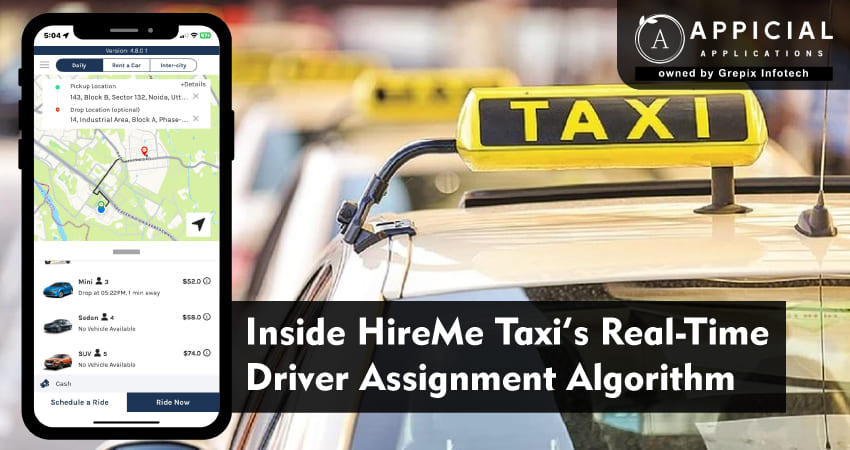
Inside HireMe Taxi’s Real-Time Driver Assignment Algorithm
In any ride-hailing system, the driver assignment algorithm is the backbone. HireMe Taxi’s version continuously matches incoming ride requests to available drivers in real time. It must balance several objectives: minimize rider waiting time, reduce driver idle travel (pick-up distance), maintain fairness among drivers, and adapt to changing demand.
At its essence, the system monitors active requests, idle drivers, and predicted future arrivals. When a request arrives, it may either be assigned immediately or delayed assignment slightly to possibly match a closer driver. It treats this as a kind of optimization problem under uncertainty. Contributions from academic research (such as Real-Time Driver-Request Assignment in Ridesourcing) show that optimal waiting thresholds and dynamic matching models help reduce overall system cost.
HireMe’s algorithm combines real-time and predictive components. It weighs pick-up cost, waiting cost, predicted driver arrivals, and churn (requests that may abandon). The algorithm runs frequently, on each new request or driver update. The model is designed to scale to the city level.
Because HireMe functions similarly conceptually to an Uber Clone or a ride-sharing app / ride-hailing app, the same architectural patterns apply. A well-constructed driver assignment module is essential for any e-hailing app or white label taxi booking app. A reliable white label taxi app development company must implement such an assignment engine. Any full taxi app development company competing in this space must build or integrate this core logic.
This article takes a deep dive into how HireMe Taxi’s real-time driver assignment algorithm works. We analyze trade-offs, methods (linear assignment, waiting thresholds, reinforcement learning), and how it handles dynamic supply and demand. We explore how an Uber Clone, ride-sharing app, ride-hailing app, or e-hailing app would benefit. We examine what features a white label taxi booking app or a white label taxi app development company must replicate, and what core modules a taxi app development company should build. We answer key questions and set up a path for deploying similar algorithms.
Which Matching Strategies Does HireMe Taxi Use?
Does it use linear assignment or greedy matching?
HireMe’s algorithm likely alternates between greedy and assignment-based strategies. In moments of low load, a greedy approach (assign nearest driver) suffices. In high load, it formulates a linear assignment problem to optimally match multiple requests and drivers in a time window. In research, linear assignment for city-scale dispatching has been shown to minimize total system cost (waiting + travel) more effectively than rule-based dispatch.
In effect, HireMe divides time into short windows and periodically solves a matching problem for the set of pending requests and idle drivers. It updates the cost matrix (driver ↔ request) and picks assignments minimizing total cost. This approach mimics what a robust Uber Clone or ride hailing app must do to stay efficient under load. It will outperform simplistic nearest-driver logic, especially in dense demand zones.
Does the algorithm wait to assign or match instantly?
HireMe introduces deliberate waiting windows in some cases. Instead of immediately assigning to the first available driver, it can wait a short time to see if a closer driver becomes available. This waiting strategy trades a bit of rider waiting time for lower pick-up cost. In research, the optimal waiting threshold is determined based on the arrival distributions of drivers and request quitting behavior (if a user abandons waiting).
If no better driver appears within the threshold, it assigns the existing one. This logic helps reduce “deadheading” (drivers traveling long to pick up) and increases system efficiency. It’s a technique any serious ride-sharing app in the Uber Clone family should incorporate.
Does it use prediction or reinforcement learning?
To further improve matching, HireMe likely incorporates predictive models or reinforcement learning. The algorithm learns from historical patterns to estimate where demand will arise, which drivers will become available, and how to preemptively position supply. Recent work in RL dispatching (e.g. in published ride-hailing systems) has shown gains over myopic rules.
This predictive component helps the algorithm anticipate future requests and incorporate expected arrivals into its cost calculations. This forward-looking view differentiates a premium ride-hailing app or e-hailing app from a naive Uber Clone. A white label taxi booking app or taxi app development company must support plugging in prediction engines to deliver strong performance.
What Cost Components Does the Algorithm Minimize?
When HireMe matches a driver and a request, it computes a cost that typically includes:
- Waiting cost: the time the rider waits until pick-up.
- Matching cost (pick-up distance): travel time for the driver to reach the rider.
- Future opportunity cost: by assigning this driver now, you might forego better matches later.
The total cost is often a weighted sum:
TotalCost = α × WaitingCost + β × MatchingCost + γ × FutureCost
Here α, β, γ are tunable parameters. HireMe calibrates them carefully. High α penalizes long waits; high β penalizes long pick-ups; γ penalizes disruption of future optimal matching.
When solving an assignment over multiple pairs, the algorithm sums pairwise costs and picks the assignment minimizing total cost. This is the foundation of a linear assignment approach. This cost-based architecture is essential for any Uber Clone, ride-sharing app, ride-hailing app, or e-hailing app. A white label taxi booking app must expose these cost-tuning knobs. A white label taxi app development company should deliver modules for cost configuration. A taxi app development company building from scratch must build this cost engine.
How Does the Algorithm Scale & Maintain Responsiveness?
City-scale systems receive thousands of requests per minute. The driver assignment algorithm must run in milliseconds. HireMe optimizes for computational efficiency using:
- Sparse cost matrices: Only consider candidate drivers near the request, not every driver globally.
- Windowing/batching: Group new requests and evaluate in short time windows rather than one by one.
- Incremental updates: reuse previous computations; update costs only for changed entries.
- Heuristics/prunings: Discard obviously suboptimal pairs early.
- Approximate algorithms: Use fast approximations instead of exact solutions for huge scales.
Through these optimizations, HireMe ensures that its real-time driver assignment algorithm can support large fleets and high request volumes without delay. This is critical for any serious Uber Clone or ride-hailing app, and must be built by a capable taxi app development company or integrated by a white label taxi app development company.
What Trade-Offs & Edge Cases Does the Algorithm Handle?
Balancing fairness to drivers vs system optimality
If the algorithm repeatedly favors certain drivers (closer, more active), others may be starved. HireMe addresses this by adding fairness metrics or quotas: ensure minimal assignments to each driver over time. This is important in ride-sharing app design to maintain driver morale.
Handling request abandonment and driver refusal
Sometimes riders leave (cancel) while waiting. Or drivers decline assignments. The algorithm needs to factor in a quitting probability or penalty for unassigned requests. It must reassign or re-route dynamically. This ensures robustness in real-world conditions.
Demand surges & peak times
During surges, the algorithm’s matching logic must adapt—raising weights on waiting time, relaxing pick-up distance constraints, or enabling surge assignments. HireMe’s model shifts cost weights to favor faster matches under high load.
Changing driver availability and disruptions
Drivers may go offline mid-move; traffic conditions change. The assignment module must handle reassignments or dynamic route adjustments. Real-time sensing frameworks (such as receding-horizon control) help mitigate idle distance and supply imbalance.
These edge conditions show why implementing a robust real-time assignment algorithm is nontrivial. Any e-hailing app, ride hailing app, Uber Clone, or ride sharing app must build resilience. A white-label taxi booking app or a white-label taxi app development company must build in reassignment logic. A full taxi app development company must integrate fallback, dynamic updates, error recovery.
Also Read: Taxi App Features | Taxi Booking App Features List
What Are Best Practices When Building Such an Algorithm?
- Modular architecture: separate matching engine, cost engine, prediction engine, fallback logic.
- Parameter tuning & A/B testing: constantly tune α, β, γ weights in production.
- Real-time monitoring & feedback loop: track waiting times, pick-up distances, rejection rates.
- Fallback strategies: if matching fails, use greedy assignments or nearest-driver rules.
- Simulation before deployment: run simulations on synthetic or past data to verify.
- Scalable infrastructure: use microservices, distributed computing to handle load spikes.
- Logging and traceability: for debugging mismatches or anomalies.
- Continuous learning & retraining: update prediction models and driver arrival estimates.
These practices ensure that your version of a ride-sharing app, ride-hailing app, Uber Clone, or e-hailing app remains robust. Even if your platform is built on a white-label taxi booking app, the provider must still follow these practices. A competent white-label or taxi app development company will embed these best practices from day one.
How Can You Validate Your Algorithm’s Performance?
You must measure the algorithm by real metrics:
- Average rider waiting time.
- Average pick-up travel time.
- Rate of unserved requests or cancellations.
- Driver idle rate or deadheading distance.
- Throughput: number of served rides per time unit.
- Fairness: variance in assignments per driver.
- System response latency (milliseconds per match).
Run offline simulations and real controlled A/B experiments. Adjust parameters based on results. Only a robust monitoring setup will make your assignment engine competitive.
Conclusion
The heart of a high-performing Uber Clone, ride-sharing app, ride-hailing app, or e-hailing app lies in its real-time driver assignment system. HireMe Taxi’s algorithm demonstrates how combining linear assignment, waiting thresholds, predictive modeling, and scalability tricks enables optimal matching in complex urban settings.
If you seek to build or improve such a capability, you need a partner that understands both the theory and the intricacies of implementation. Appicial Applications excels in building modular, scalable, and predictive dispatch engines. We customize matching algorithms, tune cost weights, integrate predictive models, and embed fallback logic.
Whether you are launching a full ride-sharing app, ride-hailing app, or assembling a white label taxi booking app, working with Appicial Applications ensures you will get a robust, high-performance platform. As an experienced white-label taxi app development company, we help transform your transportation vision into technically elegant, reliable, production-grade systems.
Ready to build the next hire-me level dispatch engine? Contact Appicial Applications now and let’s design a future that's a match.
FAQs
Author's Bio

Vinay Jain is the Founder at Grepix Infotech and brings over 12 years of entrepreneurial experience. His focus revolves around software & business development and customer satisfaction.
Back to blog list




